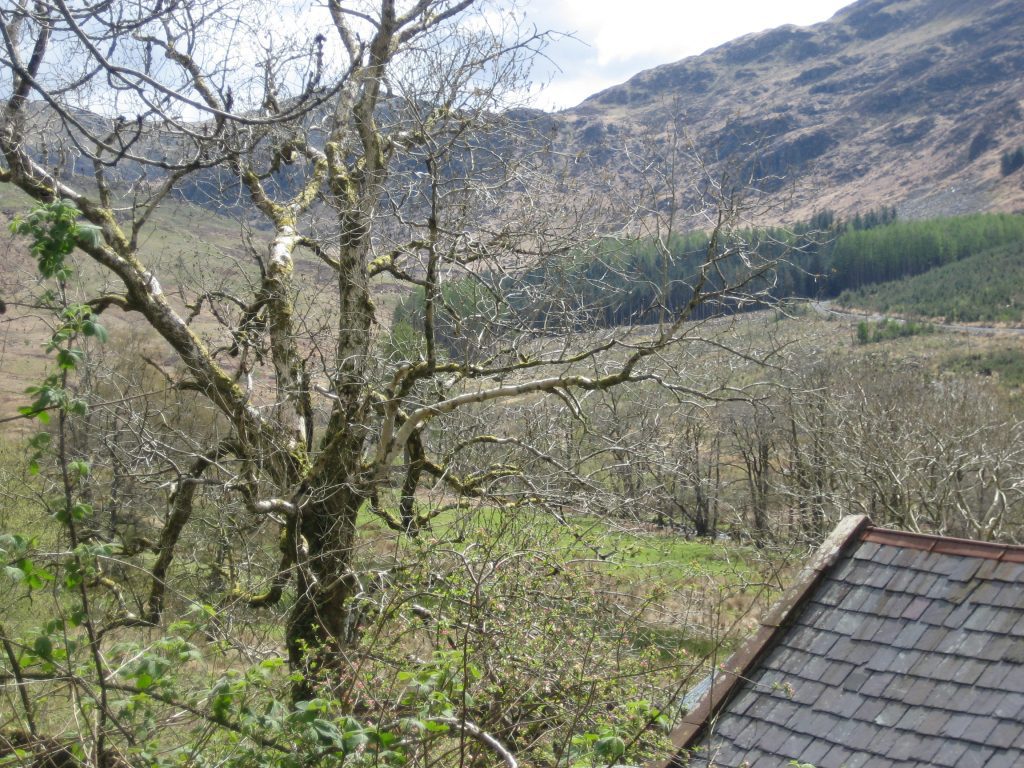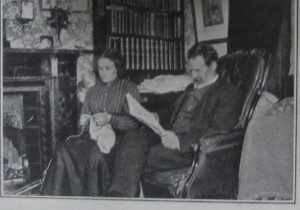November is the month we are called to remember and if I might extend the analogy into Crockett-land I hope you will not think me disrespectful. I believe there is an important point to be made and an important battle being fought with respect to our natural and cultural heritage.
As writer in residence for Dumfries and Galloway (2002-2004) I undertook quite a lot of work ‘remembering’ J.M.Barrie. We celebrated the 100th anniversary of The Admirable Crichton in 2002 and Peter Pan in 2004. At the time Mote Brae was languishing, unloved and seemingly unwanted. And the Theatre Royal Dumfries was in dire need of some TLC. A decade or more on, both have found new life. But it’s not been easy and I can’t help but think that if such places were ‘maintained’ to begin with they wouldn’t need to be ‘conserved’ or indeed ‘restored’ at huge cost. I am also painfully aware that for every winner there are many losers.
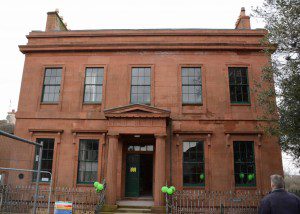 [picture Mote Brae, Copyright R.B Photography]
[picture Mote Brae, Copyright R.B Photography]
I believe conservation and restoration sit on a spectrum which runs from demolition to development, and sadly it often seems a profit motivated spectrum with little attention paid to our natural or cultural heritage, be this place or people.
J.M. Barrie and S.R.Crockett are two men of whom the people of Dumfries and Galloway should be rightly proud. They were also friends. In 1893-4 they hatched a plan to go and visit their mutual friend R.L. Stevenson in Samoa. But Barrie got sick, then married and Crockett’s publishing career went into orbit and before they could carry out their plan (or hare-brained scheme) Stevenson died.
Stevenson is now well remembered, (it’s his birthday on 13th of this month by the way!) but it wasn’t always so. Barrie’s reputation is undergoing ‘restoration’ but as for Crockett? Well, I’m heartened to see that his memorial at Laurieston is finally going to get some attention – it was in a disgraceful state when I visited for the 100th anniversary of his death in 2014. But there is still much to do to conserve and restore him to his rightful place in our cultural heritage.
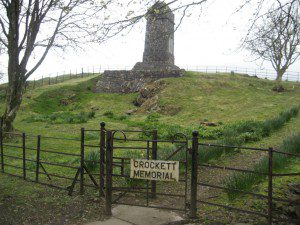 [picture Laurieston memorial]
[picture Laurieston memorial]
The phrase ‘sense of place’ is very fashionable at the moment. And Crockett is the foremost writer of natural Galloway, so he can lay claim to being significant for both our natural and cultural heritage. He has links with Glenhead of Glentrool which is not as lucky as Mote Brae, yet which is every bit as important.
The last farming tenant was put out in the late 1990’s and since then it was ‘managed’ by the Forestry Commission. Like Mote Brae before it, it was essentially left to rot. More recently there was talk of the farm house being demolished. It is a robust dwelling house of granite which stands at the end of a valley and you can (with good eye sight and a clear day) see it all the way from by Bruce’s Stone. The land it sits in is indescribably beautiful. More than that, it is a place of natural, cultural and historic significance. Faced by an outcry at the thought of demolition, early this year the Forestry Commission put it up for sale. I know that they were aware of its significance, and the Crockett connection, because I told them. I also told the estate agents marketing the property.
Glenhead is now being ‘developed.’ And the signs are not good. There appears to be no care taken towards the natural, cultural or historic significance.
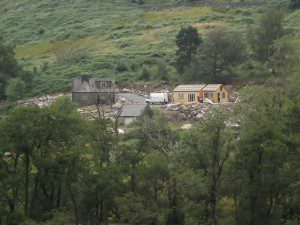 [picture Glenhead ]
[picture Glenhead ]
This picture suggests that significant trees, boulders, flora and fauna have all been devastated. There are others who know better than I of the full extent of loss of natural flora and fauna, but the key point is – it has been done. Much of what Glenhead was beyond the granite building is beyond conservation now. No one can save it. We now rely on Crockett’s words for our remembrance.
‘Glenhead I saw for the first time in the broad glare of a mid-noon sun. All the valley swam in a hazy blue mist and the heat smote down from the white lift as through the glass of a hothouse.’
The road gradients along Troolside are steep as the roof of a house. From more than one point on the road the loch lies beneath us so close that it seems as if we could toss a biscuit upon its placid breast. The deep narrow glen may be flooded with intense and almost Italian sunshine. But the water lies cool, solid, and intensely indigo at the bottom. Far up the defile we can see Glenhead, lying snug among its trees, with the sleeping giants of the central hills set thick about it. Nor it is not long till, passing rushing burns and heathery slopes on our way, we reach it.’
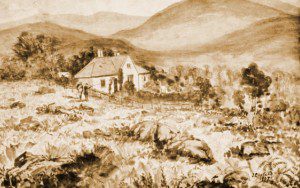 [picture Glenhead ]
[picture Glenhead ]
We had a Galloway Raiders walk to Glenhead in May of this year and I will long cherish the memory. It was still possible to imagine the place (overgrown and run down as it was) as the place Crockett visited the Macmillans
Crockett introduces us to a Glenhead full of life and love; ‘Heartsome content within, placid stillness without as we ride up—a broad straw hat lying in a friendly way upon the path—the clamour of children’s voices somewhere down by the meadow—a couple of dogs that welcome us with a chorus of belated barking—this is Glenhead, a pleasant place for the wandering vagabond to set his foot upon and rest awhile. Then after a time, out of the coolness of the narrow latticed sitting-room (where there is such a collection of good books as makes us think of the nights of winter when the storms rage about the hill-cinctured farm), we step, lightly following, with many expectations, the slow, calm, steady shepherd’s stride of our friend—the master of all these fastnesses—as he paces upwards to guide us over his beloved hills.’
There is no such welcome at Glenhead today.
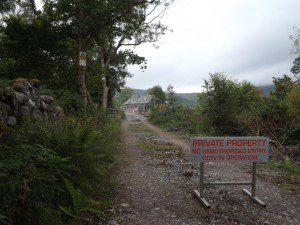 [picture Glenhead ]
[picture Glenhead ]
Whatever happens to Glenhead in its next incarnation, be of no doubt, we have already lost something hugely significant that we will not get back. It’s not the first time, it won’t be the last and of course in the global scale of things it’s trivial. But it’s part of a cultural sickness. In my opinion it is at the very least constructive demolition. All that is significant there has been wiped from the face of the earth. The life and heart have been ripped out of the place.
Questions should be asked: Why is Glenhead not as important as Mote Brae? Why could it not have been conserved as a place of natural, cultural and historic importance? Why was it allowed to get to this state of affairs?
It’s not lack of will on the part of the community, but lack of funds. But why should we have to buy back our natural and cultural heritage from those tasked with conserving it? I suggest that Land Reform has a long way to go in actually being meaningful to the ordinary man and woman in the hills never mind the streets. I only hope that the ‘Glenhead’ letters between Crockett and Macmillan housed at Broughton House at Kirkcudbright are cared for better than the farm has been. They are in the public domain and it would be nice if the public could have open access to them!
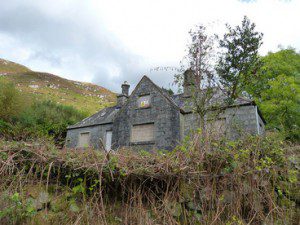 [picture Glenhead ]
[picture Glenhead ]
Glenhead is an important warning of what happens when we stop remembering. I don’t believe we should have to fight to preserve our own countryside any more than we should have to fight to get our great writers (and artists) recognised. But we should appreciate them. We should ask questions of those who claim to look after our heritage for us, and we should cry shame on all those who fail to live up to their responsibilities on our behalf. I suggest that every one of us should care a lot more than we do about our natural and cultural heritage. And make our voices heard.
It is with people as it is with places. If you care for the countryside, you need to care for Crockett. Already the only way you can experience The Bogle Thorn, Abbey Burnfoot and The Sheil of the Dungeon of Buchan are through his writing. Crockett did all he could to conserve and preserve Galloway and her beauty for future generations. What are we doing for the generations to come after us? I’ve dedicated more than three years (and continue to do so) to making Crockett’s work available. It is an act of remembrance and respect. But it’s up to you to do the reading. If you care for Galloway, I urge you to do so. It’s not just about reading fiction, it’s about engaging with your natural and cultural heritage. All too much of which is already lost.
Cally Phillips
Volume I of Discovering Crockett’s Galloway (Crockett Country) covers Glenhead and many other parts of the Galloway hills and Volume 2, due out next spring will continue the journey towards other ‘lost’ Galloway places including Abbey Burnfoot and The Bogle Thorn. This and all 32 volumes of The Galloway Collection are available direct online from the Galloway Raiders store in ebook and paperback editions www.gallowayraiders.co.uk While you’re there, you might like to join The Galloway Raiders as a gesture that you care for Galloway’s nature, culture and history.

